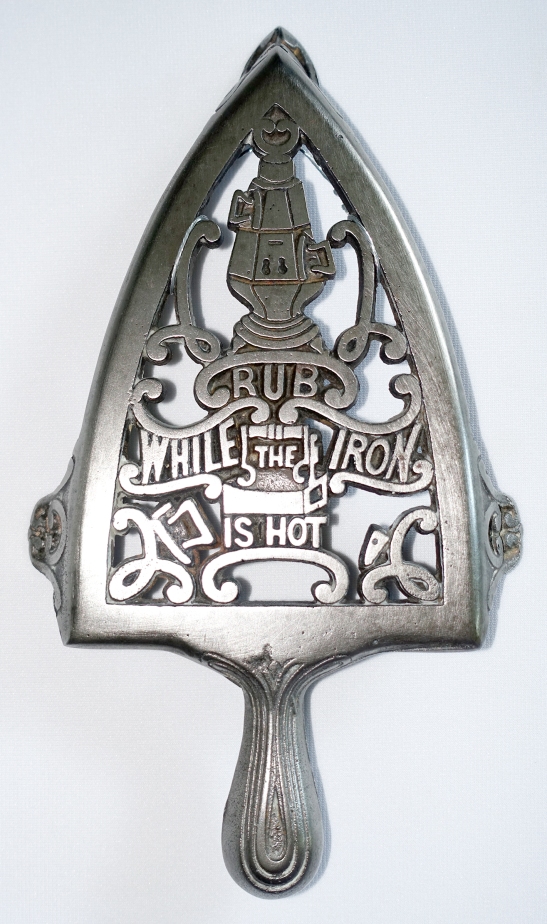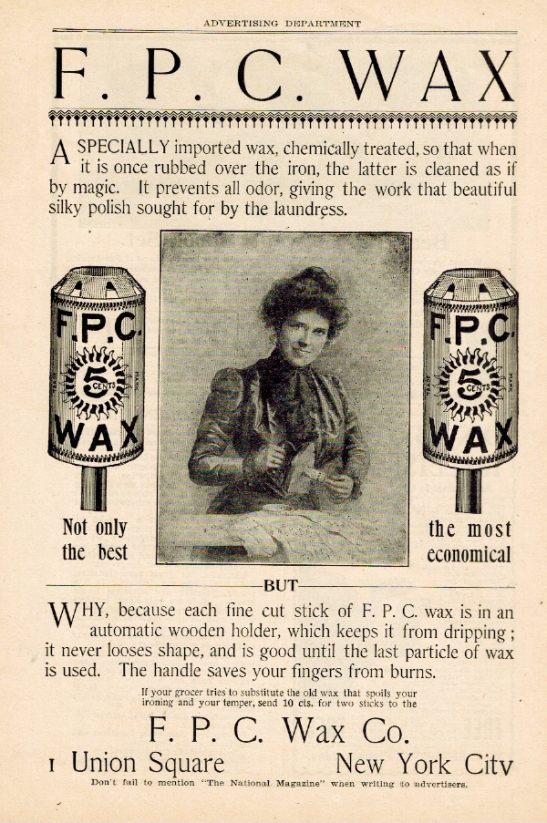TRIVETOLOGY
Collecting, cleaning, displaying, researching, and appreciating TRIVETS and related go-withs!
Rub While The Iron Is Hot
Nickel plated cast iron stand, original finish, 9 1/2 x 4 3/8″ w/three 1” legs.
This antique Scottish design is one of my favorites! Its spade shape would have accommodated a medium sized iron. Although the terms trivet and iron stand are often used interchangeably, in my opinion iron stand best defines this beautiful casting.
The reverse is signed Greenlees of Glasgow (Scotland) and bears the registered design number Rd 35659 for the year 1885.
The legend “Rub While the Iron Is Hot” refers to the practice of rubbing an iron’s soleplate with wax to clean the ironing surface, make the iron slide more easily, and to prevent the iron from sticking to freshly starched fabric. Here’s a 6.5″ x 9.5″ advertisement in The National Magazine for F.P.C. Wax sticks, circa 1902. “The handle saves your fingers from burns.”
So far I’ve found two versions of this iron stand: one in nickel plated cast iron and the other in brass. (Unfortunately a previous owner drilled two hanging holes in the brass version, top and bottom.) The rim on both stands extends into three decorative splayed leg supports. Note that, while the tops were polished, the bottoms typically were not; each reverse has a dark patina. I believe Greenlees also produced this design in cast iron with a black japanned finish. I have a space reserved in my collection for that one!
Look closely and you’ll discover a number of interesting items incorporated into this iron stand’s design:
● In the upper part of the design is a wood burning laundry stove in the process of heating several flat irons.
● Wrapped around the word THE is a box iron.
● In the lower part of the design look for a polishing iron (lower left) and the box iron’s heatable slug (lower right).
Nickel plated cast iron (L) and brass (R). I use wire to hang my trivets.
☆ Warning: The preservation of patina is always a consideration when dealing with antique metalware. Weigh your options carefully before deciding to strip, sand blast or re-plate a finish.
In the process of upgrading I was left with one “Rub While The Iron Is Hot” stand that was structurally sound but the surface was quite rough. The nickel finish was flaking with rust underneath, making it difficult to clean and polish. Any attempts to remove the rust resulted in further loss of plating.

I decided to send this trivet to Brian Spandl, who also replated my Queen Spirit stove. Now my replated stand approximates how it most likely looked when new.

While replating will protect the casting and make it serviceable, it can devalue an antique trivet. It also would never be mistaken for an original finish. Compare the shiny appearance of this freshly re-plated trivet to the patina of the antique stand at the top of the page. The aged nickel on the 130+ year old stand has a wonderful, rich luster that would be almost impossible to reproduce.
Update 6/6/20
For cleaning a nickel-plated trivet, I recommend trying soap and water and a soft rag or sponge first. Fill a container full of warm water and add a mild dishwashing detergent until the water appears soapy. Hot water, cold water, abrasive soap or a rough brush can damage the plating! Then rinse and carefully dry the trivet with a soft towel. Follow with a polish intended for nickel. I’ve had success using Flitz Polish for polishing and protecting my nickel-plated trivets.
Avoid using Flitz or a similar polish on an electroplated surface like EPNS (electroplated nickel silver) because it could lift the top (silver) layer off.





